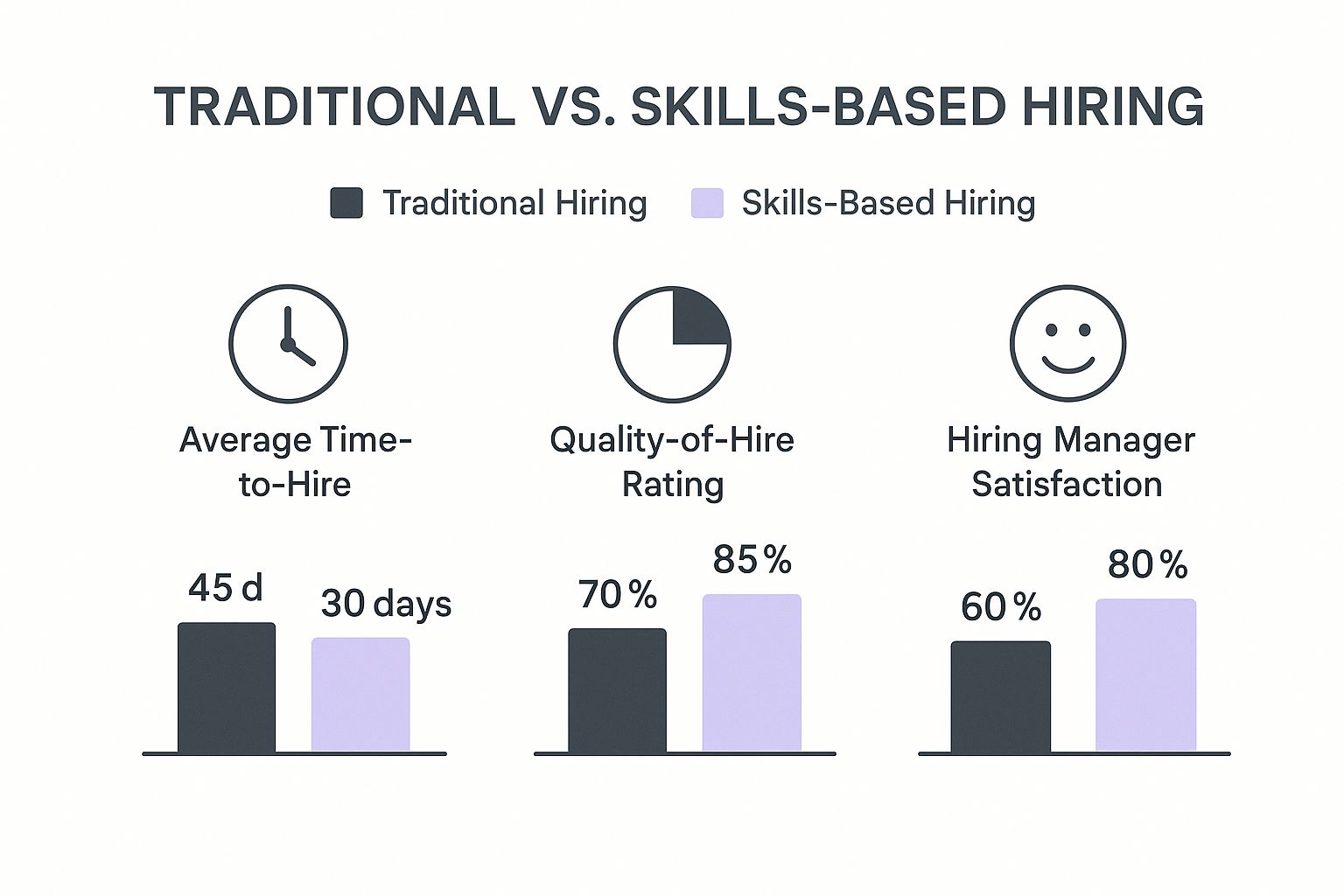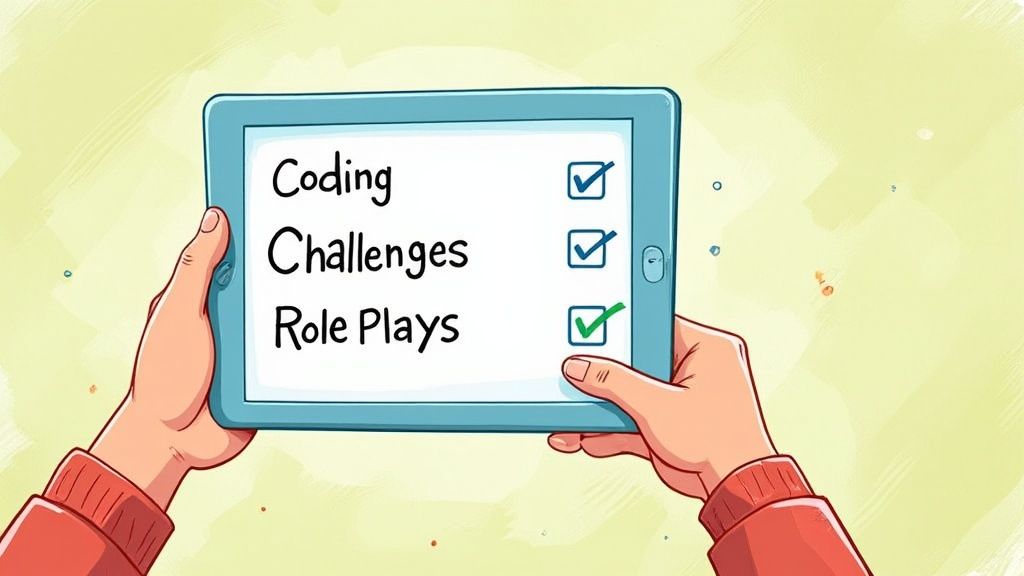
Let's cut the HR jargon. Skills-based hiring is built on one simple, brutally effective idea: hire people for what they can do, not where they went to school or what their last job title was. It’s about swapping resume fluff for real, verifiable skills.
For years, we’ve all played the same broken game. A candidate polishes their resume with the right keywords, we scan it for a fancy degree or a familiar company name, and then we cross our fingers, praying they can actually perform on the job. It's a system built entirely on proxies—lazy assumptions that a certain education or title equals competence.
But let’s be honest. How many times have you hired someone who looked perfect on paper, only to discover they couldn't execute their way out of a wet paper bag? It’s a costly, soul-crushing cycle. You waste weeks interviewing, more weeks onboarding, and suddenly you’re back at square one, wondering how you’re going to cover the cost of another bad hire.
This traditional approach isn’t just inefficient; it’s a leaky bucket. It automatically screens out incredible, self-taught talent while over-indexing on pedigree. Hope you enjoy spending your afternoons fact-checking resumes—because that’s now your full-time job.
Skills-based hiring flips the script. Instead of asking, "Where did you work?" it asks, "Can you show me how you solve this problem?" It prioritizes tangible abilities over credentials. This isn't just a fleeting trend; it's a fundamental shift driven by the cold, hard reality that the old way is broken.
The core idea is simple: If you need someone to build a financial model, you find someone who can build a great one—whether they learned at Harvard Business School or through online courses in their basement. Proven ability trumps a prestigious logo every time.
This practical approach is gaining serious traction for a reason. Between 2020 and 2024, the percentage of companies using skills-based hiring jumped from 40% to 60%, largely because of persistent talent shortages. Companies are finally realizing the old ways just don't work anymore. You can read the full research on these hiring trends to see just how much the landscape is changing.
This chart visualizes the clear advantages of switching to a skills-based hiring model over traditional methods.

The data clearly shows that a skills-first approach doesn't just feel better—it delivers faster hires, better-quality candidates, and happier managers.
To put it in perspective, here's a quick comparison showing the fundamental differences between the old way of hiring and the new, skills-focused approach.
| Factor | Traditional Hiring (The Old Way) | Skills Based Hiring (The Smart Way) |
|---|---|---|
| Primary Focus | Resumes, degrees, past job titles, and years of experience. | Verifiable skills, competencies, and practical abilities. |
| Candidate Evaluation | Based on proxies and assumptions (e.g., a good degree = a good employee). | Based on direct evidence of skill through assessments, projects, and portfolios. |
| Talent Pool | Limited to candidates who fit a very specific, often rigid, profile. | Broad and diverse, including self-taught talent and career-changers. |
| Interview Process | Relies heavily on behavioral questions and self-reported experience. | Emphasizes work-sample tests, technical challenges, and problem-solving scenarios. |
| Diversity & Inclusion | Often perpetuates bias by favoring candidates from similar backgrounds. | Reduces bias by focusing on objective performance, leading to more diverse teams. |
| Success Predictor | Weak. Past titles and education are poor predictors of on-the-job success. | Strong. How a candidate performs on a relevant task is a great predictor of future performance. |
The takeaway is clear: one method relies on hoping you found the right person, while the other focuses on proving you did.

Let's get blunt. That old-school assumption that a college degree is a golden ticket to top talent? It’s not just outdated—it’s actively holding your business back. We’ve all been there: mesmerized by an Ivy League logo on a resume, only to hire someone who couldn't find their way out of a paper bag once the real work started.
Relying on credentials is a lazy shortcut for gauging competence. It’s a move that feels safe but ultimately leads you straight off a cliff. You burn weeks sifting through nearly identical resumes, running interviews that favor charm over capability, and then wonder why your new hire isn’t delivering. It’s a slow, expensive, and shockingly inaccurate way to build a team.
And the worst part? For every "perfect" candidate you interview, you're ignoring a dozen brilliant, hungry self-starters who simply didn't follow the traditional four-year path.
This obsession with degrees creates what’s known as the “paper ceiling”—an invisible barrier that locks out perfectly capable people. These are the developers who taught themselves to code, the marketers who built an audience from nothing, and the salespeople who can sell anything to anyone but lack a specific piece of paper.
By requiring a four-year degree for a role that doesn't need one, you aren’t filtering for quality. You’re filtering for privilege. This inevitably leads to homogeneous teams that think alike, innovate less, and fall victim to groupthink. It’s a recipe for stagnation. If you're looking to build better, more dynamic teams, it's worth reviewing modern inclusive hiring practices.
Tough love time: Your current process is likely slower, more biased, and less effective than you realize. It's a system built for a world that no longer exists, and it's causing you to miss out on the very people who could change your company's future.
The good news is, we’re not the only ones who’ve figured this out. The market is waking up. A 2025 survey revealed that nearly 65% of employers are now actively using skills-based hiring methods to find their people. This is a huge shift away from old-school metrics like GPA, which fewer than 40% of employers even bother to screen for anymore. You can dig into the numbers yourself in the full hiring trends report.
This isn't just a feel-good trend. It's a smart, pragmatic response from businesses tired of gambling on credentials. They're choosing to bet on what people can actually do. The only question is, are you going to keep playing the old game, or are you ready to start winning?

So, you're on board with the concept. Great. Now comes the real work: putting it into practice. Shifting to a skills-based hiring model isn't some abstract HR theory; it’s about engineering a smarter, more precise machine for finding the right people.
It starts by forgetting everything you know about scanning resumes for the "right" keywords or prestigious university names. This approach is all about breaking a role down into its most essential components and then finding a way to test for those specific abilities.
It’s a structured, no-fluff playbook built on three core pillars.
First things first: your job descriptions need a complete overhaul. Stop writing laundry lists of daily duties. Nobody is inspired by phrases like "attending weekly meetings" or "collaborating with cross-functional teams." That’s just corporate noise.
Instead, you need to define the actual skills a person needs to succeed. Ask yourself: what must someone in this role be able to do from day one to be effective?
Let’s take a “Content Marketer” role. The old way is vague. The new way gets specific:
See the difference? We've shifted from fuzzy responsibilities to concrete, measurable skills. This clarity is the bedrock for everything that follows.
Once you know exactly what you’re looking for, you need a reliable way to measure it. This is where the magic really happens. You stop asking candidates to tell you they're great and start asking them to show you.
This means creating assessments that mirror the actual work they’ll be doing day-to-day. No more pointless brain teasers or asking what kind of animal they’d be. We're talking about practical, real-world tests that prove capability.
The goal of a good assessment isn’t to trick the candidate; it’s to give them a genuine opportunity to demonstrate their competence. It’s the difference between asking a chef about their favorite recipes and just asking them to cook you a meal.
There are many ways to do this, and the best platforms for pre-employment skills testing offer a variety of formats. Your choice of assessment should directly reflect the skills you pinpointed in the first pillar.
This single step is incredibly effective at filtering the talkers from the doers.
Finally, it’s time to redesign your interview process. The goal is to focus on competency and problem-solving, not just charm and a vague sense of "culture fit." The interview shouldn't be a casual chat; it should be the final verification stage of their skills.
This is your chance to dig into their assessment results. Ask them to walk you through their thought process, explain the choices they made, and discuss how they’d approach different scenarios. It becomes a collaborative problem-solving session, not an interrogation.
A structured interview process ensures every candidate gets a fair and equal shot. More importantly, it keeps your team focused on evaluating the skills that actually matter for the job. No more hiring your buddy’s cousin because they told a good story. You’re now hiring the person who proved they can do the job—and that's how you build a team that wins.

Alright, theory is great, but let's talk about what really matters: results. It's one thing to talk about changing the game; it's another to see who's actually winning with the new rules. This isn't some niche strategy for scrappy startups, either. The biggest names in the business are already all-in.
Think about companies like Google and IBM. For years, they were the poster children for hiring based on pedigree—Ivy League degrees, perfect GPAs, the works. But even these giants saw the writing on the wall. They dropped degree requirements for a massive number of roles because they realized a simple truth: a framed diploma doesn't write code or close a sale.
They swapped resume-scanning bots for practical, skill-based assessments, opening their talent pools to a world of brilliant people they had previously ignored. This isn't just a PR move; it's a cold, calculated business decision to get the best talent, period.
This shift is happening everywhere, and it's happening fast. By 2025, a staggering 81% of companies in the United States had already adopted skills-based hiring practices, ditching the old degree-first mindset. Major players like LinkedIn are actively recruiting candidates with verified skills over formal education because it's proven to be a better predictor of success. You can learn more about this industry-wide shift and see just how far behind the old model has fallen.
These companies aren't just making a statement. They're building a massive competitive advantage by accessing a deeper, more diverse, and more capable talent pool than their slower-moving rivals.
It’s not just about the big guys, either. I’ve seen mid-sized companies completely transform their teams by embracing this approach.
Let’s look at a real-world case. A growing SaaS company I know was stuck in the classic hiring mud pit: long hiring cycles, inconsistent new-hire performance, and a team that all looked and thought the same. Their process was a mess of resume roulette and unstructured "vibe check" interviews.
They decided to make the switch. Here’s what happened:
The results were insane. They cut their average time-to-hire in half and saw new-hire performance jump by 30% within the first six months. They stopped gambling on resumes and started making informed investments in people who could actually do the work. These aren't just feel-good stories; they are clear, profitable outcomes you can replicate.
Let's be real. Switching to skills-based hiring sounds great in a blog post (ahem), but making it work isn't as simple as deleting "Bachelor's Degree Required" from your job descriptions. It’s a full-system upgrade, and if you’re not careful, you can end up with a process that’s just as broken as the old one, only with more spreadsheets.
I’ve seen plenty of well-intentioned efforts crash and burn for a few predictable reasons. This is your insider’s guide to dodging those landmines before they blow up your hiring budget.
First up is the toughest hurdle: leadership buy-in. You’ll inevitably run into a senior leader who still believes a prestigious university name is a magical proxy for talent. Trying to convince them with feel-good arguments about fairness is a losing battle.
You have to speak their language: data and results.
Don't argue about philosophy; present a business case. Show them the numbers on how much a bad hire costs, the faster time-to-fill from a wider talent pool, and the performance metrics of skills-vetted hires versus resume-vetted ones.
Lead with data from a pilot program. Pick one or two roles, run a skills-first process, and track everything. When you can walk into that meeting and say, “We hired two engineers who outperformed the last four hires, and we did it 30% faster,” the conversation changes. Suddenly, you’re not just an HR idealist; you’re a strategic partner.
Excited to finally test for skills, some teams go way overboard. They design a "work sample" that’s actually a full week of unpaid labor or a coding challenge that requires solving world hunger. Hope you enjoy radio silence from your top candidates—because that's exactly what you'll get.
Your assessment must be a scalpel, not a sledgehammer. It should be:
A great employee selection process isn't about hazing candidates; it’s about efficiently validating their skills. Anything more is just you trying to get free work, and the best talent will see right through it.
So, you’ve got buy-in and a slick new assessment. Awesome. But can you run it for ten roles simultaneously without your team having a collective meltdown? A process that relies on one hiring manager’s heroic efforts isn't a process—it's a bottleneck waiting to happen.
To make it stick, your new system must be repeatable, fair, and scalable. This means creating standardized scoring rubrics for every assessment, training all hiring managers on how to conduct structured interviews, and using tools to keep everything organized.
Without that foundation, your well-intentioned initiative fizzles out by the next quarter, dismissed as "that thing we tried once."
Alright, we’ve covered the what, why, and how. Now for the million-dollar question: Is blowing up your old, comfortable hiring process actually worth it?
The short answer is yes. The longer, more accurate answer is hell yes.
Look, nobody enjoys overhauling a core business function. It takes real work. But the alternative is far more painful—continuing to gamble on resumes and praying the charming candidate you just hired can actually do the job. That’s not a strategy; it’s a slow-motion disaster that bleeds money and morale.
Switching to skills-based hiring isn't about feeling progressive; it's about getting tangible results that show up on your bottom line. Let's get down to brass tacks.
In fact, a major upside of a skills-first approach is improving candidate experience. Candidates genuinely respect a process that values their actual talent over credentials.
Ultimately, this is about building a team that is measurably more effective. Turns out there’s more than one way to hire elite developers without mortgaging your office ping-pong table.
This isn’t just a better way to recruit—it's the only way to build a company that consistently wins.
Alright, let's tackle a few of the common questions and—let's be honest—a bit of the healthy skepticism I hear from founders and hiring managers who are on the fence about skills-based hiring. It’s smart to kick the tires before you drive the car off the lot.
Look, I get it. Your hair is already on fire. The idea of adding another step to your hiring process probably sounds like a nightmare.
Initially, yes, there's some upfront work. Defining the core skills for a role and building a solid assessment takes a minute. But think of it as spending an extra hour now to save 100 hours of agony—and a boatload of cash—dealing with a bad hire down the road. It’s an investment that pays for itself the first time you dodge hiring a smooth talker who can’t deliver.
Long-term, it's dramatically faster. You spend less time slogging through pointless first-round interviews and more time with a small pool of people who have already proven they can do the work.
This is the big one. How do you test for things like "teamwork" or "communication" without asking those cringey, predictable questions like, "So, are you a team player?"
Simple: you build scenarios that force candidates to demonstrate those skills. You don't ask, you observe.
Instead of asking if they can collaborate, give them a real-world problem and have them walk you through their solution with a team member. You’ll learn more in that 30-minute session than you would from a dozen canned behavioral questions.
For communication, ask them to explain a complex topic from their assessment to a non-expert. Their ability to distill complicated ideas into simple terms tells you everything you need to know.
Absolutely not. This is for any role where performance matters more than pedigree. The principle is universal: test the skills required to do the job well, whatever that job is.
You just need to get creative with your assessments.
Stop thinking about roles and start thinking about skills. That’s the core of skills-based hiring, and it works for everyone from the front desk to the C-suite.
